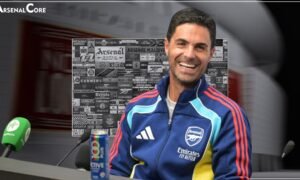Since taking charge of Arsenal in December 2019, Mikel Arteta has spearheaded a significant tactical revolution at the club. Drawing from his experience under Pep Guardiola, Arteta has implemented a dynamic and progressive style of play that has rejuvenated Arsenal on the pitch. Before you get into the details, place a bet on eSports in Uganda online.
Building from the Back: A Solid Defensive Foundation
One of Arteta’s primary focuses has been establishing a solid defensive foundation. By prioritizing the construction of attacks from the back, Arsenal aims to maintain possession and control the game’s tempo. This tactical approach allows the team to patiently break down opposing defenses while minimizing the risk of turnovers.
Emphasis on Ball Retention: Dominating Possession
Under Arteta’s guidance, Arsenal has shifted towards a possession-oriented playing style. The team’s players are encouraged to showcase their technical skills, maintaining possession and patiently waiting for gaps to appear in the opposition’s defensive structure. This deliberate approach helps Arsenal control the flow of the game and create scoring opportunities with precision.
Fluid Positioning: Unlocking Defenses Creatively
Mikel Arteta has implemented a fluid system that encourages players to rotate positions seamlessly during matches. This tactical flexibility serves as a powerful weapon in breaking down opposition defenses, as it creates confusion and uncertainty among defenders. The fluid positioning also allows Arsenal’s creative players to find pockets of space, enabling them to exploit weaknesses in the opposition’s backline effectively.
Structured Defensive Shape: Reducing Vulnerabilities
The defensive structure has been a key aspect of Mikel Arteta’s tactical revolution. Arsenal’s players maintain their positions diligently, ensuring compactness and reducing the spaces for opponents to exploit. This structured approach provides a solid foundation, making it difficult for the opposition to penetrate the defense and limiting their scoring opportunities.
Collective Pressing: Regaining Possession Proactively
Arteta has emphasized the importance of collective pressing throughout the team. Arsenal’s players work cohesively to apply pressure on the opposition, forcing turnovers in dangerous areas of the pitch. This proactive defensive strategy disrupts the opposition’s rhythm and provides Arsenal with immediate attacking opportunities.
Creative Midfielders: Architects of Arsenal’s Style
Players like Emile Smith Rowe and Martin Ødegaard have flourished under Arteta’s guidance, given the freedom to roam and dictate the tempo of the game. Their vision, passing ability, and intelligent movement have added a new dimension to Arsenal’s attacking prowess.
Quick Transition Play: Capitalizing on Turnovers
Arteta’s system emphasizes rapid transition play, aiming to catch opponents off guard during defensive turnovers. Arsenal swiftly transitions from defense to attack, exploiting the pace and movement of players like Pierre-Emerick Aubameyang and Bukayo Saka. This quick transition style catches opposition defenders out of position and enables Arsenal to create scoring opportunities with devastating speed.
Involvement of Fullbacks: Expanding the Attack
The fullbacks provide width and overlap, stretching the opposition’s defense and creating additional attacking options. Arteta recognizes the importance of utilizing fullbacks as key assets in the team’s attacking play. This strategic involvement of fullbacks adds unpredictability to Arsenal’s attacks and increases the pressure on the opposing defense.
Strategic Set-Piece Plays: Gaining an Edge
Under Arteta’s tutelage, Arsenal has shown improvement in their set-piece plays. Detailed strategies and well-rehearsed routines have been implemented to gain an advantage in dead-ball situations. By maximizing their opportunities from corners, free-kicks, and throw-ins, Arsenal has found another avenue to score goals and disrupt the opposition’s defensive organization.
Mental Resilience: Building a Winning Mindset
In addition to the tactical changes, Arteta has placed a strong emphasis on building a winning mindset and mental resilience within the squad. He has implemented a culture of accountability, professionalism, and high standards, demanding commitment and discipline from his players. This shift in mentality has been crucial in helping Arsenal overcome challenges and maintain focus during difficult moments in matches.
Adaptability in Tactical Approaches: Tailoring the Game Plan
Another notable aspect of Arteta’s tactical revolution is his ability to adapt and tailor the game plan to specific opponents. He analyzes the strengths and weaknesses of opposing teams and formulates strategies accordingly. This flexibility has allowed Arsenal to approach each game with a unique plan, maximizing their chances of success against different styles of play.
Improving Squad Depth and Recruitment: Strengthening Arsenal’s Core
Arteta has been involved in reshaping Arsenal’s squad through targeted recruitment. The signings of players like Thomas Partey and Gabriel Magalhães have addressed specific positional needs and added quality to the team. Arteta’s involvement in the recruitment process ensures that new additions align with his tactical vision and fit seamlessly into the team structure.
Continual Evolution: The Arteta Philosophy
Arteta’s tactical revolution at Arsenal is an ongoing process. He constantly seeks improvement, both in the team’s performance and in his own coaching methods. The evolution of Arsenal’s playing style under Arteta is a testament to his dedication, adaptability, and commitment to developing a team capable of challenging for major honors.
Mikel Arteta’s arrival at Arsenal has brought about a remarkable tactical revolution, reshaping the club’s playing style and reinvigorating the team on the pitch. From building a solid defensive foundation to emphasizing possession-based football, Arteta has instilled a new identity and philosophy in the squad. The inclusion of fluid positioning, collective pressing, and the involvement of fullbacks have added new dimensions to Arsenal’s attacking play.
























